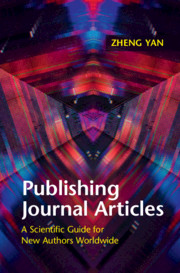Book contents
- Publishing Journal Articles
- Publishing Journal Articles
- Copyright page
- Dedication
- Contents
- Figures
- Preface
- Part I Nature of Journal Article Publication
- Part II Elements of Journal Article Publication
- Chapter 3 What Makes Our Manuscripts Publishable?
- Chapter 4 Who Are the Authors of Journal Articles?
- Chapter 5 Who Are the Readers of Your Articles?
- Part III Strategies of Planning Journal Articles
- Part IV Strategies of Writing Journal Articles
- Part V Strategies of Publishing Journal Articles
- Part VI Future of Journal Article Publication
- Index
Chapter 3 - What Makes Our Manuscripts Publishable?
from Part II - Elements of Journal Article Publication
Published online by Cambridge University Press: 27 October 2020
- Publishing Journal Articles
- Publishing Journal Articles
- Copyright page
- Dedication
- Contents
- Figures
- Preface
- Part I Nature of Journal Article Publication
- Part II Elements of Journal Article Publication
- Chapter 3 What Makes Our Manuscripts Publishable?
- Chapter 4 Who Are the Authors of Journal Articles?
- Chapter 5 Who Are the Readers of Your Articles?
- Part III Strategies of Planning Journal Articles
- Part IV Strategies of Writing Journal Articles
- Part V Strategies of Publishing Journal Articles
- Part VI Future of Journal Article Publication
- Index
Summary
Journal articles are the basic element located in the middle of journal article publication. After discussing students’ intuitive thoughts and real-life cases (Susan, Singer, and Einstein), the chapter presents the core concept related to journal articles, that is, scientific contributions. It is scientific contributions that make a manuscript publishable. Advancing scientific knowledge and improving human life are the ultimate goals of publishing journal articles. Scientific contributions can be further analyzed, in terms of (1) intended, perceived, and accomplished contributions, (2) empirical, synthesizing, theoretical, methodological, and practical contributions, and (3) directions and degrees of scientific contributions. Multiple practical suggestions are offered in the end: understanding that scientific contributions, rather than innovative ideas, graceful writing, or rigorous research, make a manuscript publishable, that scientific contributions are related to advancing scientific knowledge and improving human life, that scientific contributions are related to intended, perceived, and accomplished ones, that various types of contributions, such as empirical, synthesizing, theoretical, methodological, and practical, can be achieved, and that directions and degrees of scientific contributions can vary.
Keywords
- Type
- Chapter
- Information
- Publishing Journal ArticlesA Scientific Guide for New Authors Worldwide, pp. 25 - 35Publisher: Cambridge University PressPrint publication year: 2020

